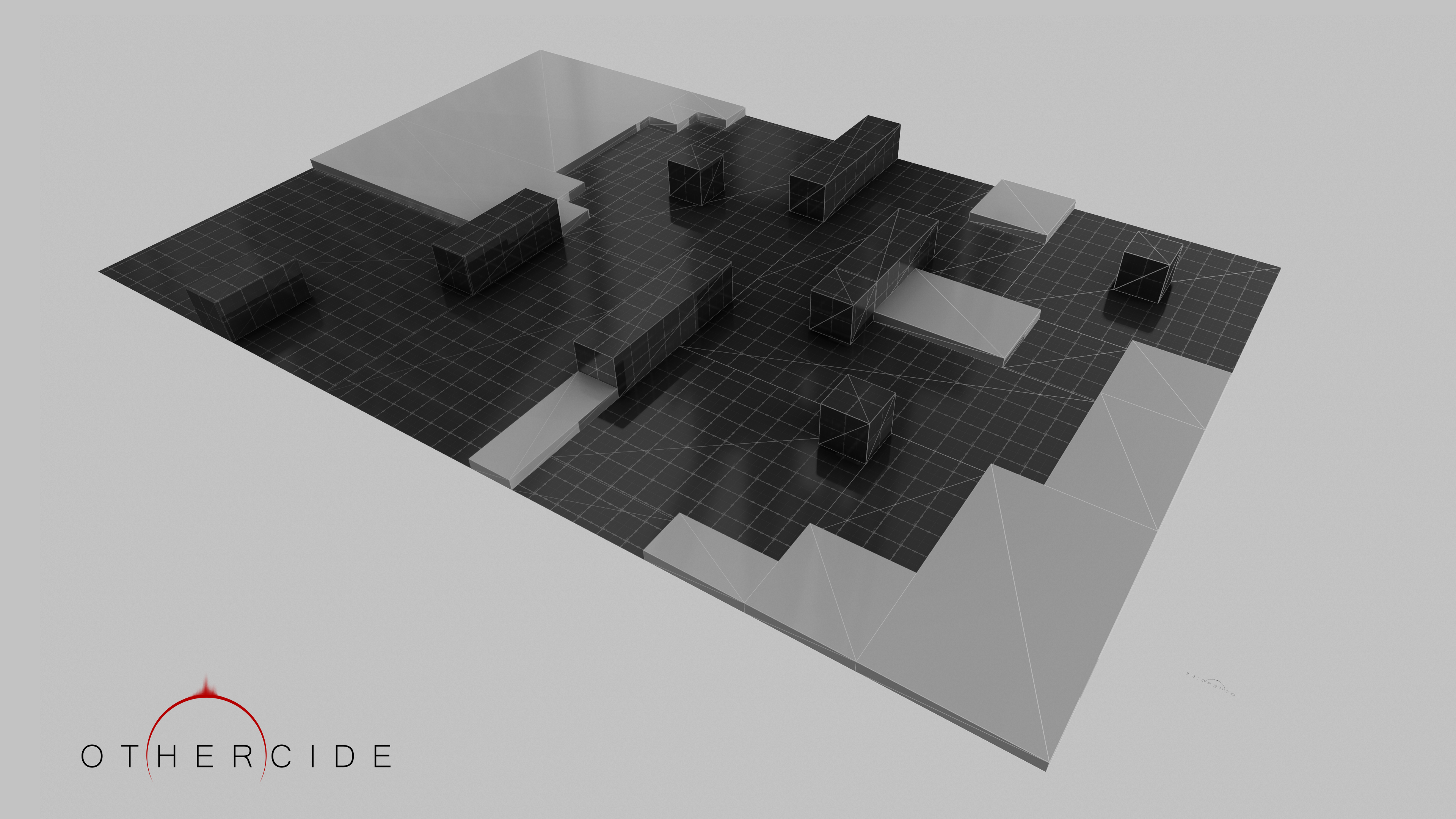Our initial intension was to project the player in a 20th century Paris inspired by Lovecraft’s work and horror tales. An unknown Paris, far from the usual « Haussmannian » representation commonly used and represented. From there, a real architectural and historical investigation begins: finding the right balance between reality and structure, the gameplay mechanics and the twisted vision envisaged by the Art Director.
Three main « environment types » will emerge from these initial researches: the dark alleys and backstreets of the City, the underground veins of the subways and a dark, disturbing, « inbetween two realities » realm… The Dark Corner.
Architects of Nightmares (Production)
Before getting started on crafting 3D environments, we must establish some primordial rules for the production pipeline. In the case of Othercide, a tactical turn-based game, the main interrogations were the camera angle and range of movement, the size of our levels, the proportions of the tactical grid, the maximum polycount we could afford… and lots of technical issues!
Once the fog dissipated on those unknown topics, we could launch the 3D assets creation. An Environment Artist will have two principal types of asset to create: « modules » and « props ».

The modules will constitute the « basis » of the background: walls, grounds, floors, cliffs… The props are complementary objects that enhance the environment: floor lamps, benches, trees, statues, dark crystals, floating paintings or disturbing clay figures…
Modules are comparable to LEGO bricks: put them together and each combination creates new backgrounds and a great variety of environments. For example, the frontage of a Parisian building is an assembly of several modules: walls, windows, gutters, roofs… Very quickly, we can obtain a good variation of the same asset type, composed with different modules.

The first step of a modular pipeline construction is working exclusively with primitive shapes. Actually, the tricky part of this process isn’t the 3D execution but the initial conception and logic, when you have to establish the number of modules necessary and their sizes for a good scope of variation, as well as making sure that they all imbricate themselves perfectly.
Once the logic is fixed and clear, we can start the in-game assets production.

Either modules or props, our workflow doesn’t change: modeling and UV unwrapping of the meshes on Maya, with a complementary sculpt phase on Zbrush if necessary. The PBR texturing is done with Substance Designer or Painter, and the final integration is completed on Unity.
Building the Shattered Reality (Inspiration and Creation)
Othercide is built around an « emergent narration »; like in the Dark Souls series (magisterially crafted by From Software), we encourage our players to explore our environments, finding hidden glimpses of a wider lore, through compositions, staging and sound design.
If you look closely, you will notice the storytelling behind our statues’ compositions, if you keep your ears open you will probably hear a strange melody coming from the abyss…
Have you noticed that all our Parisian signs are written backwards? We never push « upfront » the narration: you are brought in backstage of reality, in an « in-between » of the two worlds, with few descriptive explanations. It is the players’ choice to dig in our details and discover the full lore, hidden behind the dark curtains.
The Game Designers create and provide an abstracted level design of the in-game map (white boxing): it gives us the boundaries of the playable zone as well as the inner collisions and lines of sight obstacles.

After analyzing this white boxing, we decide of the best « lore theme » to attach to this level during a meeting with the Art Director. We call these themes « Pain Chronicles » and they describe the traumatisms and afflictions of our main villain, the Child. They are the origin of our inspiration for the production of each level, and a « direction » to follow all along the process of creation.
The next step, the « blocking », is primordial: during this phase, the Environment Artist will work with existing 3D assets in order to provide composition proposals and lighting intentions. He works very roughly, developing several ideas until finding the best one that fits both the theme and the LD.
The only limits to our creativity are the boundaries of the Level Design, and of course the « Dark Corner » rules set by the art direction; for example, our shattered reality is represented by a flooded floor, a dark water lake that you will find in each level. But it is by twisting those constraints that we find the best ideas!
The blocking is validated by both the Art Director and Lead Environment, and then begins the polish step. That’s where the magic happens, by replacing the rough assets by the final ones, adding the details that bring this disturbing universe to life. Once done, the level can get his ultimate lighting pass.
The Lighting Artist’s mission is to sublimate the levels composition and storytelling, and he works hand in hand with the art direction to flesh out the narration in each map.

This is how we create the various environments of Othercide. We are excited to share with you our work and to get feedbacks from the community!
As a reminder, Othercide is coming on Steam in Early Access in 2019.
A note from the Art Director:
Othercide’s environment is a work of collaboration. They involve a lot of different departments and require a large skillset to our coworkers. I can’t thank our environment artists enough for the love and passion they brought to our shattered world. Othercide wouldn’t exist without the dark, disturbing and still fabulous canvas they painted.
Explore our rainy realm, discover our glimpses of storytelling, and build your own conclusions on what, when and where Othercide takes place.
There are no real answers in the Dark Corner… only black and white nightmares and questions.
Alex








Interesting read!
Thank you!